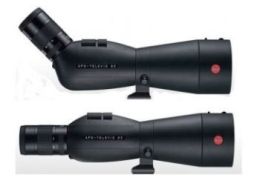Should You Buy a Straight or Angled Spotting Scope?
- Posted By Jeff Byrnes
- Blog
 When you’re trying to decide on the best spotting scope for your particular needs, one of the biggest sources of confusion is whether to buy a straight or an angled scope. Straight scopes keep the eyepiece and barrel in the same horizontal plane, but angled scopes put the eyepiece at an angle to the barrel. This angle is usually 45 or 90 degrees from the barrel, and this can have its advantages. However, both designs have both advantages and disadvantages, so you have to decide which to purchase based on how you plan on using your spotting scope.
When you’re trying to decide on the best spotting scope for your particular needs, one of the biggest sources of confusion is whether to buy a straight or an angled scope. Straight scopes keep the eyepiece and barrel in the same horizontal plane, but angled scopes put the eyepiece at an angle to the barrel. This angle is usually 45 or 90 degrees from the barrel, and this can have its advantages. However, both designs have both advantages and disadvantages, so you have to decide which to purchase based on how you plan on using your spotting scope.
Straight Spotting Scopes
As previously mentioned, a straight spotting scope will usually keep the eyepiece on the same horizontal plane as the objective lens. This might not always mean a complete straight design, though, as a porro prism spotting scope will have the eye piece slightly above the objective lens. However, both the eyepiece and the objective lens will be parallel to the ground.
Advantages:
- Easier to find and track moving targets quickly.
- Easier to use if most of your spotting is from hides or using a car window mount.
- Easier to view objects below your own level, such as when spotting from a tree stand.
Disadvantages:
- Prolonged observation can become uncomfortable
- If you’re digiscoping, the weight of your camera and adapter can make the kit less stable, offering more of a chance of harming your eyepiece.
- If you’re above average height, an appropriate and stable tripod can be more expensive and harder to carry around.
- Viewing birds in the sky is more difficult.
- If you plan to use your scope for astronomy, it can be more difficult.
Generally speaking, if you plan to use your spotting scope primarily for hunting purposes, and you do a lot of hunting from elevated positions, a straight spotting scope is your best bet. However, if you want to use your spotting scope for a variety of purposes, including astronomy or viewing other objects in the sky, a straight spotting scope can prove more difficult to comfortably spot through.
Angled Spotting Scopes
An angled spotting scope places the eyepiece at an angle to the barrel, usually either 45 or 90 degrees. This has a number of advantages, but also a few disadvantages.
Advantages:
- More comfortable to use for prolonged observation.
- Easier to view birds in the sky.
- No need to raise the tripod as much, or at all, in some cases.
- Allows for a lower height on the tripod for digiscoping, which is more stable.
- Relies on gravity more to keep the camera in place for digiscoping, which means less chance of harming your eyepiece.
- Easier to use for backyard astronomy.
Disadvantages:
- Starting out, an angled scope can make things more difficult when it comes to finding and tracking moving targets. Over time, though, you’ll get used to the design and find this disadvantage mostly goes away.
- If you do most of your spotting from hides or using a car window mount, an angled eyepiece is more difficult to use.
- An angled eyepiece makes it more difficult to view objects below your own level, such as when spotting from a tree stand.
Many people find the angled eyepiece to be more comfortable and easier to use, once they get used to it. However, if most of your spotting is done using a car window clamp or from a hide or tree stand, the angled eyepiece can make things more difficult.
Final Thoughts
Which should you choose? Honestly, both designs have their perks and drawbacks, so it comes down to your intended use. If you plan on using your spotting scope for various reasons, including both spotting from tree stands and spotting things high in the sky, you should start off with whichever design you’ll use the most.
For example, starting out with spotting scopes, I determined that I’d use the optics more often from a tree stand. Therefore, I began with a straight spotting scope. My plan from the beginning, though, was to purchase another spotting scope for my astronomy and watching birds in the air. If you have the budget for it, getting both a straight spotting scope and an angled spotting scope might be the right answer.
One final thing to consider, though, is whether you plan on sharing your view with others. With a straight spotting scope, sharing your view with someone else usually means adjusting the elevation of the tripod before you can share the image.
With an angled spotting scope, though, this often isn’t necessary. The eyepiece on most angled spotting scope usually rotates, so even children can use the scope without needing to realign it or adjust the tripod. With that in mind, I guess I would say that if your needs include sharing your view with others, the angled design makes the most sense.
This post was written by Jeff Byrnes
Hi there! I’m Jeff, an avid outdoorsman and hunter who really likes exploring new technology. I’m especially into hunting optics, which is why I’m writing these reviews! I hope you find my articles helpful in your own shooting and hunting.









Nice article. It’s a very good line for newbies.